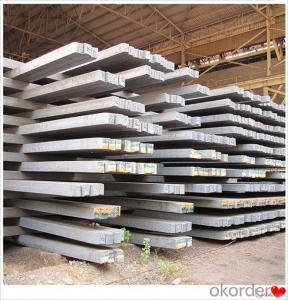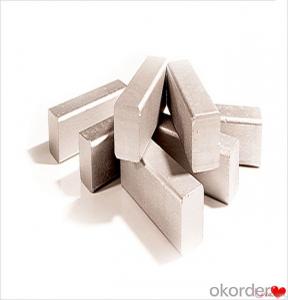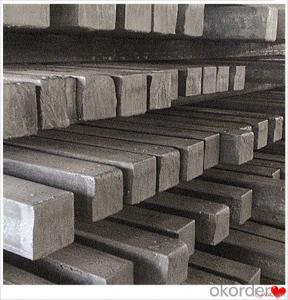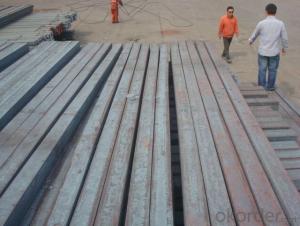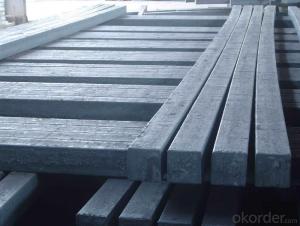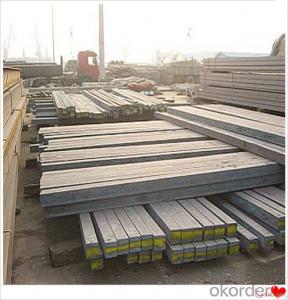Steel Billet Price Q235,Q255,Q275,Q345,3SP,5SP,20MnSi Made in China
- Loading Port:
- China main port
- Payment Terms:
- TT OR LC
- Min Order Qty:
- 20 m.t.
- Supply Capability:
- 200000 m.t./month
OKorder Service Pledge
OKorder Financial Service
You Might Also Like
Steel Billet Price Q235,Q255,Q275,Q345,3SP,5SP,20MnSi Made in China
Specification
Steel billet(ingot) by cogging or breakdown of semi-finished products, is the raw material of all kinds of steel mill. Billet section of square, round, flat, rectangular and abnormity of several kinds of, mainly related to the shape of rolled products.
CNBM Q235,Q275,Q345,3SP,5SP,20MnSi Billets Steel in Hot Sale
Hot Rolled Steel Billets/ Mild Steel Bar/ Billet Steel
Specification (see below)
Standard: GB/JIS/ASTM
Size: 50*50mm-180*180mm
Length: 3-12mtrs or Customised
Steel material: Q235,Q255,Q275,Q345,3SP,5SP,20MnSi
Technique: Hot rolled
FOB Unit Ton Price $250-350 and Usually I will quote you CFR price.
MOQ: Usually 1000-10000MT/size
Shipment:By Container,Bulk Vessel
Packaging Details: bundles with steel strips or as customers's requirements
Delivery time: Usually within 30 days after the deposit/LC
Inspection:Third party inspection before loading.
Technical data
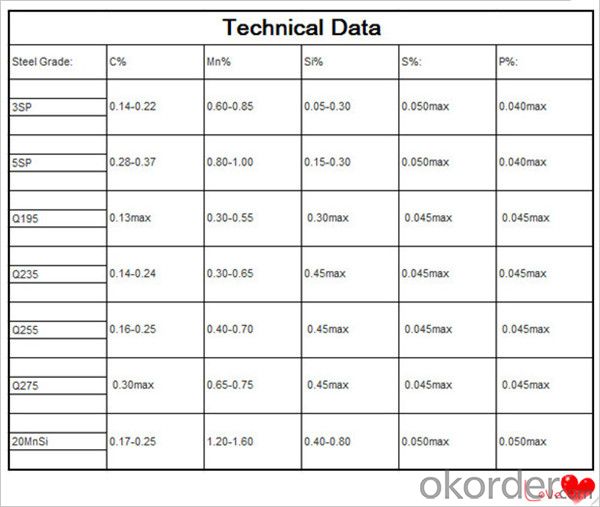
Feature Steel Billet
Rectangular billet continuous casting billet and mainly general carbon steel, low carbon low silicon cold-rolled material, high quality carbon structural steel, high strength low alloy steel, special steel, etc.
The billet is mainly divided into two kinds from the shape:
Slab: cross section width and height of the ratio of the larger, mainly used for rolling plate.
Billet: equal cross section width and height, or a huge difference, mainly used for rolling steel, wire rod. ,
Steel billets have distinct characteristics as compared with already furnished steel bars and products. Billets have a specific grain structure, which enables the metal to be processed more intricately. Steel billets are also known for their malleability and ductility, especially when exposed to varying temperatures during shaping and molding.
Packaging & Shipping
1. Packaging:
1) Small size: in bundles
2)Big size: in bulk
3)in plastic packing or as per customer requirement
2. Delivery time:
1) Normal size: within 7days send from warehouse directly
2) Special size: with 25-30days customer made for you
3. Trade terms:FOB/CFR/CIF
4. Shippment:
1) length:≤5.8m loaded in 20FT Container with 25-27tons
2) length:≤11.8m loaded in 40FT Container with 25-27tons
3) lengnth:≥12m shipped by bulk vessel, FILO terms
Steel Billet Images
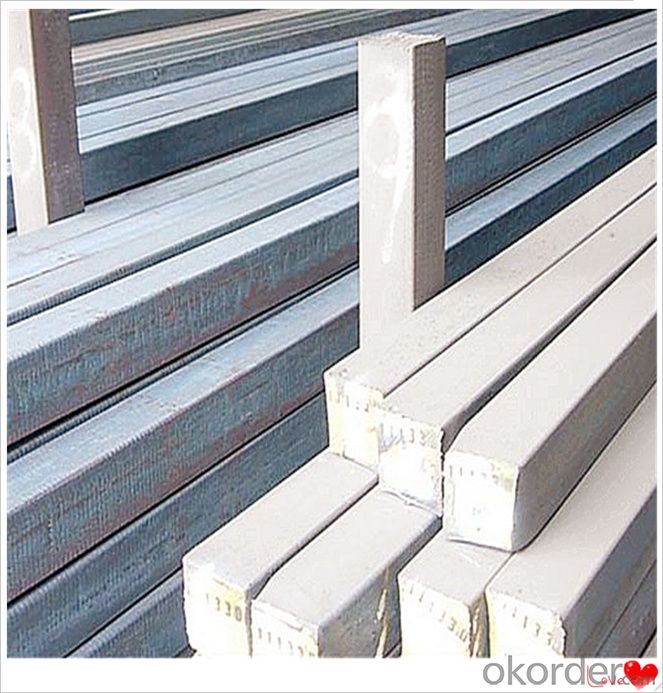
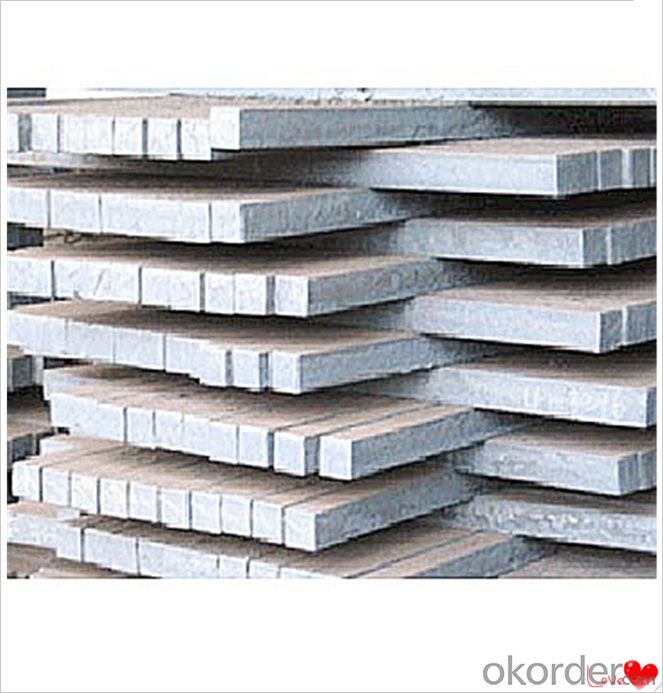
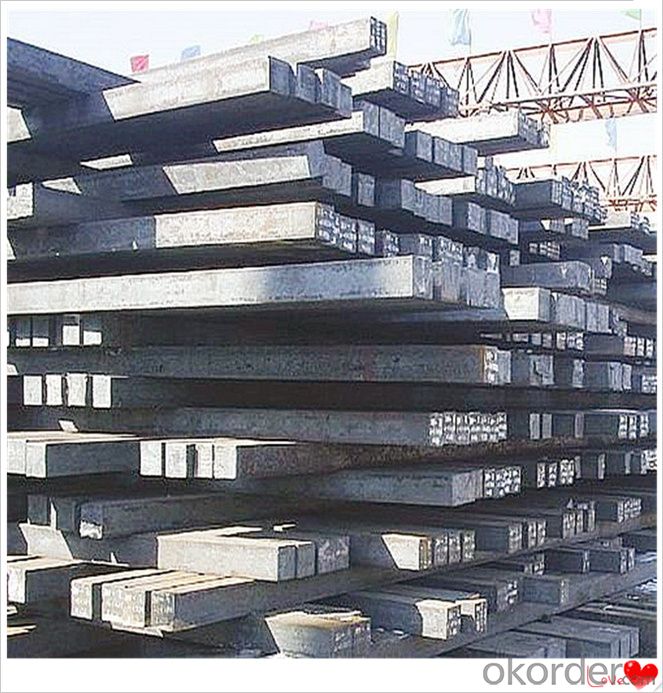

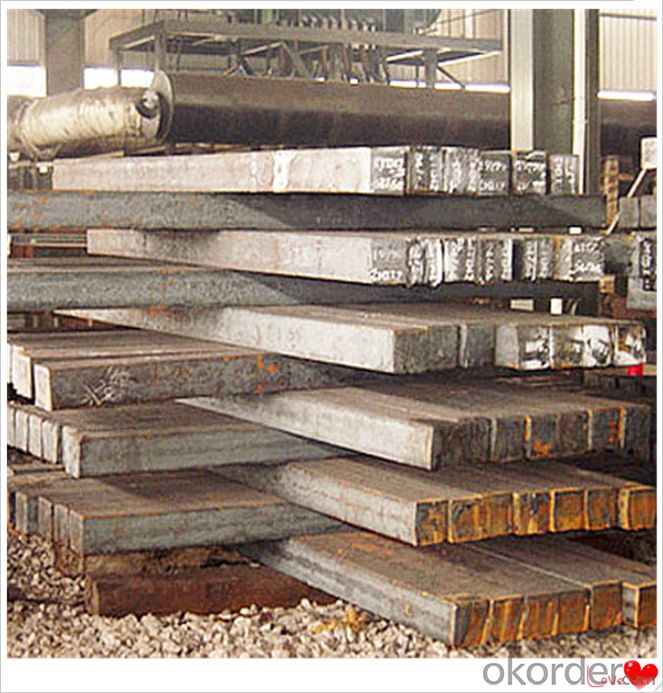
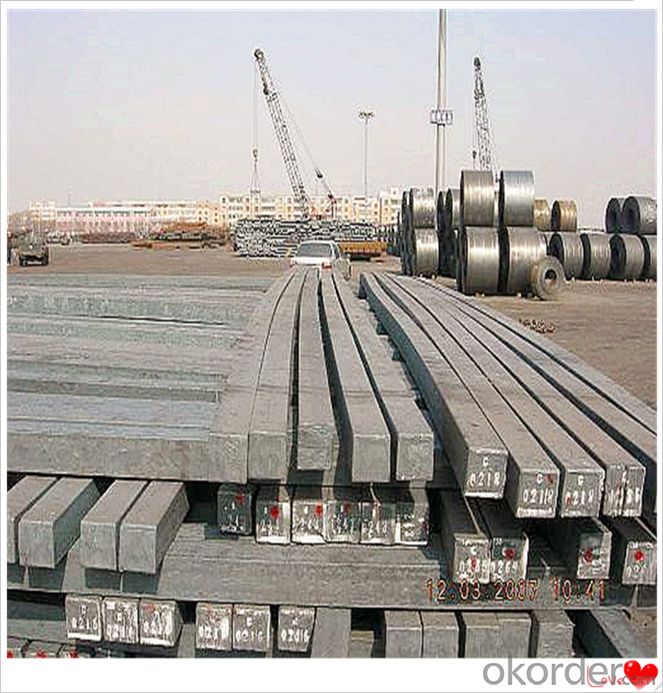
Processing
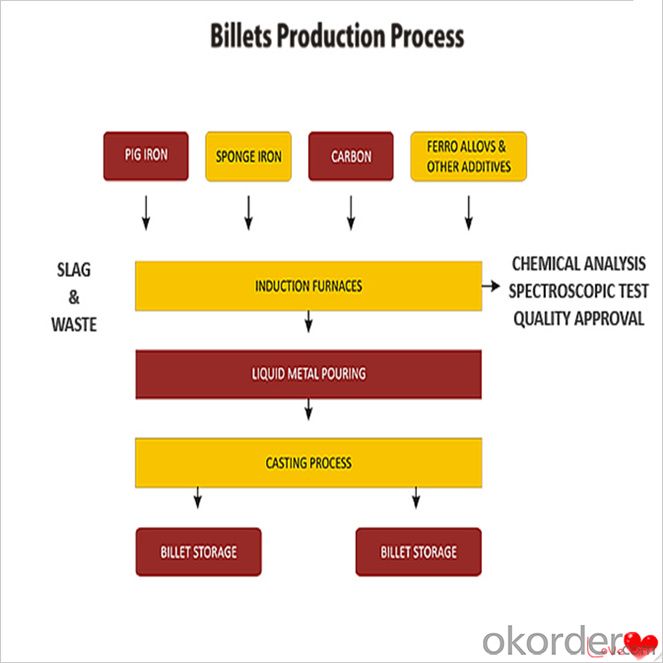
Usage-Billet Steel
Used for the plant, the bridge,shipment building high-rise building construction,lifting and transportation machinery, equipment manufracturing base building the support foundation pile manufacturing.
Billets, or ingots (as they sometimes referred to), are not of practical use until they have been formed into more functional shapes and sizes. While they have already been put in the furnace, they still require a series of shaping and molding procedures such as hot and cold working, milling and cutting before they are sold in hardware stores, or used for different applications. The unformed billets, however, can be used in striking currency such as coins and as reserves, similar to gold bars.
FAQ-Billet Steel
We have organized several common questions for our clients,may help you sincerely:
1) How about your company?
A world class manufacturer & supplier of castings forging in carbon steel and alloy steel,is one of the large-scale professional investment casting production bases in China,consisting of both casting foundry forging and machining factory. Annually more than 8000 tons Precision casting and forging parts are exported to markets in Europe,America and Japan. OEM casting and forging service available according to customer’s requirements.
2) How to guarantee the quality of the products?
We have established the international advanced quality management system,every link from raw material to final product we have strict quality test;We resolutely put an end to unqualified products flowing into the market. At the same time, we will provide necessary follow-up service assurance.
3) How long can we receive the product after purchase?
In the purchase of product within three working days, We will arrange the factory delivery as soon as possible. The pecific time of receiving is related to the state and position of customers.Commonly 7 to 10 working days can be served.
4)Do you have your own QC department?
Yes, we have, our QC department will inspect the goods during the process of mass production and after completion of production.
hot sale!!! Cast Steel Grades/ mild steel bar/ billet steel
(1): High quality steel with reasonable price.
(2): Wide excellent experiences with after-sale service.
(3): Every process will be checked by responsible QC which insures every product's quality.
(4): Professional packing teams which keep every packing safely.
(5): Trial order can be done in one week.
(6): Samples can be provided as your requirements.
- Q:How are steel billets used in the manufacturing of industrial machinery parts?
- Steel billets are used in the manufacturing of industrial machinery parts as they serve as the raw material for shaping and forming various components such as gears, shafts, and frames. These billets are heated and then passed through a series of processes like forging, machining, and welding to create the desired shape and size required for the machinery part. The strength and durability of steel make it an ideal material for industrial machinery, ensuring reliable performance and longevity.
- Q:How are steel billets recycled?
- Steel billets are recycled through a process called electric arc furnace (EAF) steelmaking. In this process, the steel billets, which are large solid blocks of steel, are melted down in an electric arc furnace. Once melted, impurities are removed, and the molten steel is then poured into molds to form new billets. These recycled steel billets can be used to produce various steel products, reducing the need for raw materials and minimizing waste.
- Q:How are steel billets used in the manufacturing of hydraulic cylinders?
- Steel billets are a fundamental part of hydraulic cylinder production, serving as the initial material for the manufacturing process. These billets, which are cylindrical shapes made of raw steel, are essential in various industries such as construction, mining, and automotive, as they provide linear force and motion. To create hydraulic cylinders, steel billets are heated and shaped using specialized machinery like hydraulic presses or hot rolling mills. This process, known as forging, involves subjecting the billets to immense pressure and heat to reshape them as required. Once forged, the steel billets are machined and precisely cut to form the necessary features, including the bore and mounting holes, essential for the hydraulic cylinder's functionality. This machining process ensures that the cylinder has the correct dimensions and tolerances. Following machining, the steel billets undergo heat treatment to enhance their mechanical properties. This involves heating the billets to specific temperatures and rapidly cooling them, resulting in improved strength, hardness, and resistance to wear and fatigue. After undergoing forging, machining, and heat treatment, the steel billets are ready for assembly into hydraulic cylinders. The various components like pistons, piston rods, seals, and bearings are carefully fitted together to create fully functioning hydraulic cylinders. In summary, steel billets play a vital role in the production of hydraulic cylinders. Through forging, machining, and heat treatment, these billets are transformed into components with the desired properties. The resulting hydraulic cylinders are then utilized in diverse applications, delivering efficient and reliable linear force and motion.
- Q:How do steel billets contribute to the manufacturing of renewable energy systems?
- The manufacturing of renewable energy systems heavily relies on steel billets, as they serve as the necessary foundation for various components. These billets are essentially semi-finished steel products that are cast into specific shapes, making them highly adaptable and versatile for different renewable energy applications. Wind turbines, for instance, require a sturdy and stable structure to support the blades and generator. Steel billets are used to construct the tower, which acts as the backbone of the wind turbine. These towers must endure harsh weather conditions and bear the weight of the blades, making the strength and durability of steel crucial. Similarly, solar energy systems, particularly photovoltaic (PV) panels, also rely on steel billets. Steel frames are utilized to provide structural support for the PV panels, ensuring they are securely mounted and capable of withstanding various environmental conditions. Additionally, steel billets are used in the production of solar trackers, which optimize the positioning of PV panels to maximize energy generation by tracking the sun's path throughout the day. Moreover, steel billets contribute to the manufacturing of hydroelectric power systems. In hydroelectric power plants, large turbines are utilized to convert the energy from flowing water into electricity. These turbines necessitate strong and reliable components, such as shafts and mechanical parts, which are often made from steel billets. The high strength and corrosion resistance of steel make it an ideal material for these applications. Furthermore, steel billets are employed in the production of energy storage systems, like batteries. These billets are used to create durable and secure enclosures for the batteries, ensuring their protection and safe operation. Steel's ability to withstand high temperatures and resist fire makes it a suitable choice for battery housing and containment. In conclusion, steel billets are indispensable in the manufacturing of renewable energy systems, providing the required strength, durability, and versatility for various components. Whether it is wind turbines, solar panels, hydroelectric turbines, or energy storage systems, steel billets play a critical role in enabling the reliable and efficient generation of renewable energy.
- Q:What is the chemical composition of a typical steel billet?
- The composition of a typical steel billet, which serves as a semi-finished material for various steel products, primarily consists of iron and carbon. However, the specific chemical composition can differ based on the grade and intended application of the steel billet. Alongside iron and carbon, different elements like manganese, silicon, sulfur, and phosphorus may also be present in varying quantities. These elements are incorporated to confer specific properties to the steel, such as increased strength, improved machinability, or enhanced corrosion resistance. To ensure the desired mechanical and chemical properties are attained, the exact composition of a steel billet is meticulously regulated during the manufacturing process.
- Q:How are steel billets used in the production of sheet metal?
- The production of sheet metal involves using steel billets in a process called rolling. Rolling entails passing steel billets through a series of rollers in order to decrease their thickness and create a flat sheet. To begin the process, the steel billets are heated to a specific temperature, which enhances their malleability. Once heated, the billets are fed into a rolling mill where they pass through a sequence of rollers that gradually reduce the thickness of the steel. As the billets are rolled, they undergo compression and elongation, resulting in a thinner and longer piece of steel. This procedure is repeated multiple times, with each pass further reducing the thickness of the steel sheet. After reaching the desired thickness, the sheet is cooled and cut into specific lengths. The end product is a flat sheet of sheet metal that can be further processed and utilized in various industries, including construction, automotive, and manufacturing. Steel billets play a vital role in the production of sheet metal as they serve as the raw material from which the sheets are formed. Their malleability and ability to withstand the rolling process make them an excellent choice for creating thin and long-lasting sheet metal.
- Q:How do steel billets differ from steel ingots?
- Steel billets and steel ingots are both intermediate forms of steel that are produced during the steel manufacturing process. However, there are some key differences between them. Firstly, the shape and size of steel billets and steel ingots differ. Steel billets are typically square or rectangular in shape, with a cross-sectional area of around 36 square inches. They are long and slender, usually measuring around 6 to 12 inches in width and 1 to 12 feet in length. On the other hand, steel ingots are generally larger and more irregular in shape. They can be cylindrical, rectangular, or even a combination of shapes, depending on the production method used. Steel ingots are usually much larger than billets, with a typical weight ranging from several tons to over 100 tons. Secondly, the production process for steel billets and steel ingots also differs. Steel billets are usually created through continuous casting, where molten steel is poured into a mold and then cooled and solidified to form a billet. This process allows for a more controlled and uniform shape, size, and composition of the billet. Steel ingots, on the other hand, are typically produced through ingot casting, where molten steel is poured into a large mold and left to solidify. This method is often used for larger steel ingots and allows for a more flexible and adaptable production process. Lastly, the purpose and usage of steel billets and steel ingots also vary. Steel billets are commonly used as raw material for further processing and shaping into various steel products, such as bars, rods, wire, and tubes. They serve as a starting point for the manufacturing of finished steel products. Steel ingots, on the other hand, are usually used for more specialized applications, such as the production of large steel components, forgings, or specialty alloys. Their larger size and irregular shape make them suitable for such demanding applications. In summary, steel billets and steel ingots differ in terms of their shape, size, production process, and usage. While steel billets are slender, square or rectangular in shape, and used as raw material for further processing, steel ingots are larger, more irregularly shaped, and often used for specialized applications.
- Q:What are the potential applications of steel billets in the transportation aftermarket?
- Steel billets offer a wide range of potential applications within the transportation aftermarket. One primary use in this industry involves using steel billets to produce various components and parts for vehicles. These billets possess the strength and durability necessary for manufacturing engine parts, suspension components, steering parts, and other critical components. Moreover, steel billets are well-suited for manufacturing structural components like chassis frames and body panels. The robustness and rigidity of steel make it an ideal material for these applications, allowing it to withstand the stresses and strains experienced during vehicle operation. Additionally, steel billets find use in producing wheels and rims for automobiles, motorcycles, and bicycles. Their exceptional strength and ability to handle heavy loads make steel billets the preferred choice for wheel manufacturing, ensuring road safety and reliability. Furthermore, steel billets can be utilized in manufacturing rail tracks and infrastructure for railways. The strength and durability of steel make it an ideal material for rail tracks, ensuring the secure and efficient transportation of goods and passengers. All in all, the applications of steel billets in the transportation aftermarket are diverse and extensive. They play a crucial role in manufacturing critical vehicle components and constructing infrastructure for railways, ultimately ensuring the efficiency, safety, and reliability of transportation systems.
- Q:How do steel billets contribute to the manufacturing of industrial equipment?
- The production of industrial equipment heavily relies on steel billets, which are essential for the manufacturing process. These semi-finished steel products are created through casting and act as the raw material for a wide range of industrial equipment. A key aspect of steel billets is their versatility, which greatly contributes to the manufacturing of industrial equipment. They possess both malleability and strength, allowing them to be easily shaped and molded into various forms, such as bars, rods, or sheets. This adaptability enables manufacturers to produce durable and reliable components and structures capable of withstanding heavy loads and extreme conditions. Furthermore, steel billets offer an impressive strength-to-weight ratio, making them particularly suitable for applications where reducing weight is crucial without compromising structural integrity. This quality proves beneficial for industrial equipment that requires frequent transportation or movement, as the use of lightweight steel billets optimizes efficiency and minimizes energy consumption. Additionally, steel billets play a significant role in protecting industrial equipment against corrosion and wear. Many industrial environments expose equipment to harsh conditions, including moisture, chemicals, and abrasion. The utilization of steel billets ensures that the equipment remains resistant to these challenges, reducing maintenance and replacement costs while maintaining performance over time. Moreover, steel billets facilitate efficient heat treatment processes during the manufacturing of industrial equipment. Through controlled heating and cooling procedures, manufacturers can enhance the mechanical properties of the steel, such as hardness, toughness, and ductility. This enables the production of equipment capable of withstanding high temperatures, extreme pressures, and dynamic loading conditions, ensuring safety and reliability across various industrial applications. In conclusion, the role of steel billets in the manufacturing of industrial equipment is indispensable. Their versatility, strength-to-weight ratio, corrosion resistance, and facilitation of heat treatment processes contribute to the creation of durable, reliable, and high-performance equipment capable of meeting the demands of diverse industries.
- Q:What are the main types of defects found in steel billets?
- The main types of defects found in steel billets are surface defects, internal defects, and segregations. Surface defects refer to any irregularities, cracks, or discontinuities present on the outer surface of the steel billet. These defects can include scale, scratches, pits, and surface cracks. Surface defects can be caused by improper handling during transportation or storage, improper handling during the manufacturing process, or inadequate surface cleaning. Internal defects are flaws or imperfections that occur within the inner structure of the steel billet. These defects can include inclusions, cavities, blowholes, porosity, and non-metallic inclusions. Internal defects can be caused by improper melting and casting processes, improper cooling and solidification, or the presence of impurities in the steel. Segregations refer to the non-uniform distribution of elements or impurities within the steel billet. This can result in areas of the billet having different chemical compositions or mechanical properties. Segregations can be caused by inadequate mixing during the melting process, improper pouring and solidification, or the presence of impurities in the raw materials. Detecting and removing these defects is crucial to ensure the quality and integrity of steel billets. Various non-destructive testing techniques such as visual inspection, ultrasonic testing, magnetic particle testing, and eddy current testing are used to identify and characterize these defects. Once detected, appropriate measures such as grinding, machining, or heat treatment can be employed to remove or mitigate the defects.
1. Manufacturer Overview |
|
|---|---|
| Location | |
| Year Established | |
| Annual Output Value | |
| Main Markets | |
| Company Certifications | |
2. Manufacturer Certificates |
|
|---|---|
| a) Certification Name | |
| Range | |
| Reference | |
| Validity Period | |
3. Manufacturer Capability |
|
|---|---|
| a)Trade Capacity | |
| Nearest Port | |
| Export Percentage | |
| No.of Employees in Trade Department | |
| Language Spoken: | |
| b)Factory Information | |
| Factory Size: | |
| No. of Production Lines | |
| Contract Manufacturing | |
| Product Price Range | |
Send your message to us
Steel Billet Price Q235,Q255,Q275,Q345,3SP,5SP,20MnSi Made in China
- Loading Port:
- China main port
- Payment Terms:
- TT OR LC
- Min Order Qty:
- 20 m.t.
- Supply Capability:
- 200000 m.t./month
OKorder Service Pledge
OKorder Financial Service
Similar products
New products
Hot products
Hot Searches
Related keywords


